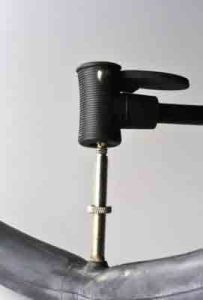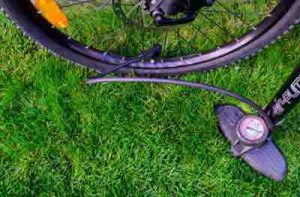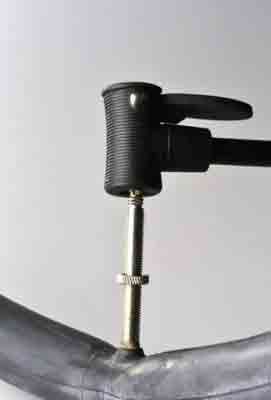Yes, you can use a car tire pump for a bike provided your tire shares an identical valve with that of your car tire pump.
Less expensive bikes and mountain bikes do have a Schrader valve and it’s also known as a car valve. If your bike tires have a Schrader valve, it will be possible for you to get air into your tubes in a pinch.
You now know you can use your car tire pump to inflate air into your bike tires, the question now is “Should you?” In most cases no.
It is not ideal unless you’re careful and you have no alternative to pumping up your tires because you’re likely to overinflate and blow out your tire due to high pressure and high volume of the air hose.
Table of Contents
How can you use a car tire pump for a bike tire?

The first thing you should know before pumping up your tire is what kind of valve is fitted. The valve is the important part that holds air in the tire but also lets you inflate or deflate the tire.
So, you should check if your bike tire has the same valve used on car tires before you can go ahead using the pump. Gobege Car Pump is a perfect example.
Then the first thing you need to do is take off the dust cap (if there is one) in the Schrader valve; then unscrew the cap anticlockwise to disclose the valve.
Now, fix the head of your pump to the valve, inflate the tire to the PSI btw the minimum and maximum as seen on the tire sidewall, then remove the pump.
You’re done and trails you go.
Follow these steps below to add air to your bike using a car tire pump accordingly.
- Identify your valve type
- Figure out the recommended PSI for the tire
- Unscrew the cap from the valve
- Attach your pump to the tire valve
- Inflate the air
Identify your valve type
This depends on your bike. The bike tire will either be Presta or Schrader valve. Which are the two common bike tire valves found on modern bikes.
You will be able to inflate air into your bike tire if it has a Schrader valve that is also seen on cars; that is making sure your car tire pump is compatible with the type of your bike valve.
Schrader valve consists of a threaded outer wall, this valve allows airflow in one direction only, you need to press the inner pin down with a tool like a pen-like object before you pump air into the tire, doing this will also let you check the air pressure in the tire.
Figure out the recommended PSI for the tire
This is usually seen on the sidewall of your bike tires and also consists of a range. You are not required to let your psi go any lower than the lowest number; The high number is the required maximum number.
The general recommendation is that road bike tire needs a higher PSI than hybrid bike or mountain bikes. Generally, the PSI range is 80-130 for road bikes, 25-35 for mountain bikes, and 40-70 PSI for hybrid or cruiser bikes.
Unscrew the cap from the valve
Schrader valves usually have plastic caps and you need to unscrew them before inflating air into the tire, the purpose of the cap, also known as a “dust cap” is to protect the valve opening from dirt or debris
Attach your pump to the tire valve
Take your car pump and position its valve end over the valve of the bike tire you are about to pump. The lever behind the valve will touch the hose in an unlocked position.
Firmly press the pump valve into the tire valve, then lift the lever to lock the pump into the tire valve.
When attaching your pump to the tire, you are likely to hear air escaping. This is natural when locking your car pump valve in place
Inflate the air
Now that the pump is well attached to the bike tires valve, it’s time to pump. This step is self-explanatory and pretty easy, you should keep an eye on the PSI as you pump.
So, check your tire pressure at regular intervals, but you should follow the recommended PSI.
Turn the lever back up to remove the pump then quickly return the rubber cap to the valve
If you are overinflated, you should remove some of the air to reach the correct PSI, press on the valve with your fingernail until enough air is out.
Simply place the Plastic cap back on the valve.
The tire should feel firm now that you’ve pumped the tire within the range of the correct PSI. Now you’re back on the road!
- Check out these cool Car tire pumps that come in handy for your bike tires.
Important checks before using a car tire pump on a bike tire

It is right that you can use a car tire pump to inflate air on a bike tire, but before you do so there are three main important aspects you have to consider:
- Valve type
- Tire volume
- Tire pressure
Valve type
From the beginning of this article, it is often said that before you can go ahead using a car tire pump on your bike tire, ensure that the bike tire has a Schrader valve (this is the same as that of a car tire).
It will be easy to inflate air with a Schrader valve, but if your bike tires have a Presta valve, you should get an adapter to enable you to use the car tire pump
Tire volume
The smaller your tires, the faster the pressure will increase, with this, you have more risk of over-inflating for road bike tires than mountain bike tires
Tire pressure
Generally, road bike tires are inflated to 110-130 PSI, which is higher than 30-40 PSI used for car tires, or the 30-60 PSI used for mountain bike tires.
The car tire pump may not be able to achieve this pressure, particularly if it’s one of those automated pumps.
So, basically, if you’ve got a mountain bike, there is not much of an issue using a car tire pump, but if you’ve got a road bike,
Kindly do yourself a favor, get a good track pump, so that you can easily top up the tires quickly anytime they go flat
Can I pump my bike tires at the gas station?
Yes, you can, only if your bike tires are using “Schrader” valves (the same valves as on car tires).
The gas station hose won’t fit if your bike tires have a “Presta” valve, you’ll have to connect it to an adapter that will convert it to Schrader.
Bike tires are usually low volume, this means the pressure will build up quickly when pumping, so you should watch the pressure closely.
You can easily overpressure the tire as gas station compressors can blow out a bike tire with ease, I mean real quick, the gas station pump is that powerful, so be forewarned.
How can I pump my bike tires at gas stations?
Sometimes, you ride past a gas station and wondered how filling your bike tires using the gas station compressors could be possible.
No worries! as easy as inflating your car tires, but you have to do so with extreme caution as gas station pumps are high on pressure and volume, this can easily cause your bike inner tubes to pop.
If you’ve ever popped your inner tubes due to overinflation, you’ll get the picture of what this is all about.
To inflate your bike tires at the gas station you first need to know what type of valve your bike tires have, there are two main types; Schrader and Presta valves.
Schrader valves are the same as car tires while Presta valves are thinner and longer with a locking nut towards the tip.
If you have a Schrader valve it is much easy to inflate your tires with a gas station pump as the air hose nozzle will fit your bike tires.
- Remove the dust cap and keep it in a safe place
- Attach the nozzle of the air hose to the tire valve then push on
- Start to inflate the tire and frequently check the pressure to make sure you don’t over-inflate (note that this can lead to a blowout)
- After inflating, fit the dust cap back on the valve
What if my tires have Presta valves?
All gas station air hoses are only designed to fit in Schrader valves as this is what car tires have.
If your bike has Presta valves, you will need to use an adapter to sit between the air nozzle and the valve to create an airtight seal.
These adapters are relatively cheap, however, you need to get one in advance as they are likely not to be available for sale at gas stations especially when you need them.
How to inflate Presta valves with an adapter
These adapters are also easy to use:
- Remove the dust cap, loosen the Presta valve locking nut
- Screw the adapter on top of the bike, and you are fine
- Connect the air hose nozzle
- Then carefully inflate your tires
- Remove the adapter when you’re done (Keep it in a safe place)
- Tighten the valve locking nut and screw the dust cap in

